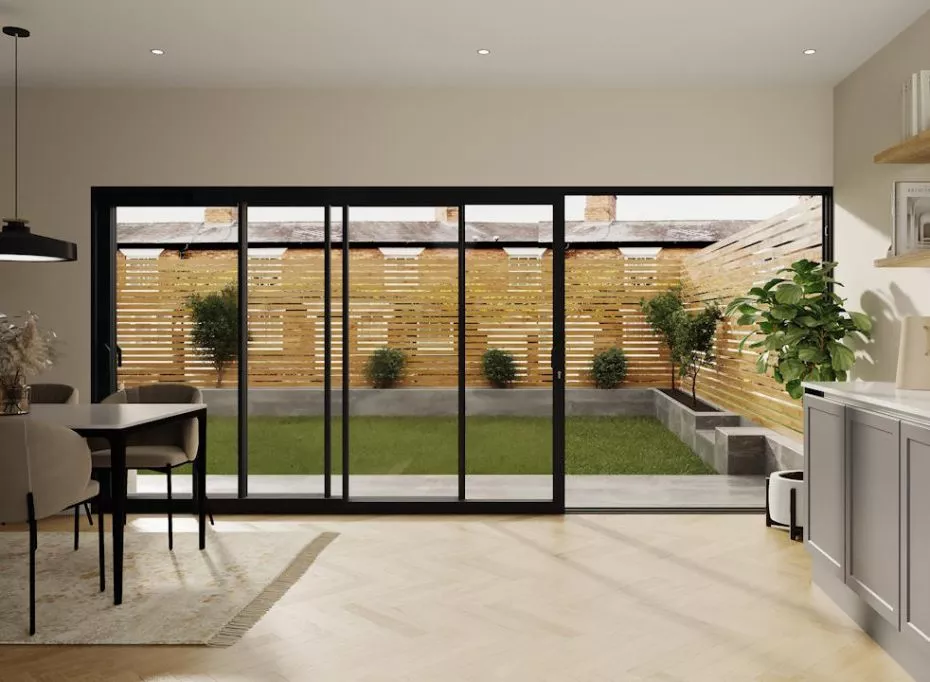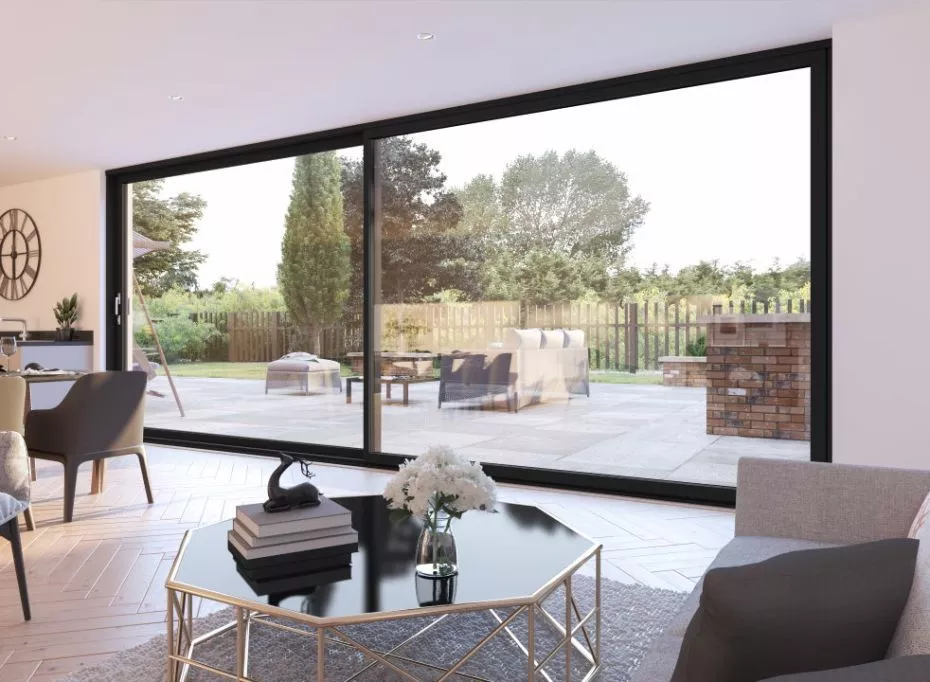Sliding Door U-Values vs. Bifold Door U-Values: How Do They Compare?
Sliding doors can be a practical, aesthetically pleasing addition to any home, with internal and external options available to make your house a home. A key aspect many consider when choosing sliding doors for their home is their U-value; the rate of the transfer of heat through the doors divided by the difference in temperature across them. A lower U-value means better thermal efficiency, but how do sliding door U-values compare to bifolds?
This guide will explore the U-values of both sliding doors and bifold doors, highlighting the benefits of low U-values, and whether thermally efficient sliding doors are worth the investment.
In this guide:
Discover how sliding door U-values stand up against bifold doors
Find out why sliding doors with a low U-value could benefit your home
Here’s how you can make your decision
There are many benefits to choosing thermally efficient sliding doors
We answer some common queries
How Do Sliding Door U-Values Compare to Bifold Door U-Values?
It's important to note that one type of door isn’t necessarily more energy efficient than the other across the board. The U-value of your internal or external sliding doors depends on various factors such as the materials used, the thickness of the door and insulation.
Our aluminium sliding patio doors are double glazed and have a low U-value of just 1.4 W/ m²k, making them the perfect choice for excellent thermal efficiency in your home. Our oak, timber and aluminium bifold doors also have U-values starting from 1.4 W/ m²k, ensuring that no matter which doors you choose, you can improve the thermal efficiency in your home.
Neither sliding nor bifold doors are inherently superior when it comes to U-values. The better choice depends on the specific configuration, materials, and insulation features of the system you're considering.

Explore our Supreme aluminium sliding door range.
What are the Benefits of Low U-Value Sliding Doors?
Low U-value sliding doors offer a range of benefits, particularly when it comes to energy efficiency, comfort, and long-term cost savings.
Improved Energy Efficiency
A low U-value means the door provides better insulation, reducing the amount of heat lost through the glazing and frame. By limiting heat transfer, low U-value sliding doors can help lower your heating bills and reduce your overall energy consumption.
Greater Year-Round Comfort
Sliding doors with high thermal performance contribute to a more consistent indoor temperature. During winter, they help keep the cold out, and in summer, they can also limit excessive heat. This makes your living space more comfortable throughout the year without overreliance on heating or cooling systems.
Enhanced Property Value
Homes that are energy-efficient are increasingly attractive to buyers. By upgrading to sliding doors with low U-values, you're not only improving day-to-day performance but also potentially boosting your property's market value.
Environmentally Friendly
Lower energy use means a reduced carbon footprint. Choosing doors with strong thermal insulation supports broader sustainability goals and can be a small but meaningful step in making your home more environmentally responsible.
You can find out more about sliding door U-values in our previous guide here.
Should I Choose Bifold Doors or Sliding Doors?
Choosing between sliding doors and bifold doors depends mainly on your personal preferences and the space available within your home. Explore our table below to make your choice much easier:
|
Feature |
Bifold Doors
|
Sliding Doors |
|
Operation |
Bifold Doors |
Panels slide along a track, typically leaving one or more fixed panes |
|
Aesthetic Style |
Panels fold and stack to one or both sides, fully opening the space |
Sleek, modern appearance with larger panes and minimal sightlines |
|
U-Values |
Creates a more segmented look due to multiple panels and frames |
Low U-values when available in double and triple glazed options, as well as when made from the right materials |
|
Space Usage |
Can achieve low U-values if well insulated and manufactured using the appropriate materials |
Panels remain in line, ideal for tighter spaces |
|
Maintenance |
Requires space for panels to stack when open |
Typically lower maintenance |
|
Best Suited For |
More moving parts and hinges may require occasional maintenance |
Homes wanting uninterrupted views and strong thermal performance year-round |

Shop our Status external sliding patio door range.
Are Thermally Efficient Sliding Doors Worth the Investment?
Thermal efficiency is a top consideration for many homeowners when choosing sliding doors. As energy costs and awareness around sustainability rise, more of us are looking for ways to make smarter investments in our homes.
Sliding doors with lower U-values can help you reduce your energy bills and enhance the comfort in your home, as well as providing long term durability with materials such as aluminium. Thermally efficient sliding doors can also improve the value of your home, making it more desirable to eco-conscious buyers.
You can browse our entire sliding door range here.
Frequently Asked Questions
What is a U-value and why does it matter for doors?
A U-value measures how effective a material is as an insulator. For doors, a lower U-value indicates better thermal efficiency and reduced heat loss, which can help lower energy bills.
Are sliding doors more energy efficient than bifold doors?
Sliding doors typically have fewer frames and more glass surface, which can allow for lower U-values when high-performance glazing is used. However, bifold doors can also achieve excellent U-values with the right materials and specification.
How do frame materials affect U-values for sliding and bifold doors?
Aluminium, timber, and uPVC frames each offer different levels of thermal performance. Timber and uPVC generally insulate better than standard aluminium, though thermal break technology has improved aluminium’s performance considerably.
Can triple glazing improve U-values for sliding and bifold doors?
Yes, triple glazing significantly reduces U-values compared to double glazing. It’s especially useful in homes seeking to meet Passivhaus or low-energy standards.
How do U-values impact long-term energy savings?
Doors with lower U-values reduce heat loss and may lead to lower heating costs over time, contributing to better energy efficiency and potentially increasing a home's EPC rating.
Should I prioritise U-values over other features when choosing a door?
While U-values are important, you should also consider security, aesthetics, ease of operation, and budget. The best option balances energy efficiency with practical and design needs.
Related Content
How to improve thermal efficiency with sliding doors
Double glazing vs. Triple glazing for sliding doors
Benefits and thermal efficiency considerations of double-glazed sliding doors

About John Collins
John has built Vufold into a unique online door and window company and has spent 20 years bringing innovative products and designs to fruition, recognising niches in the market and placing them in the likes of Wickes and Travis Perkins, he started Vufold in order to sell them directly. John founded Vufold and has amassed a wealth of experience in product design and development, and in particular timber-based products
Read more about John Collins

